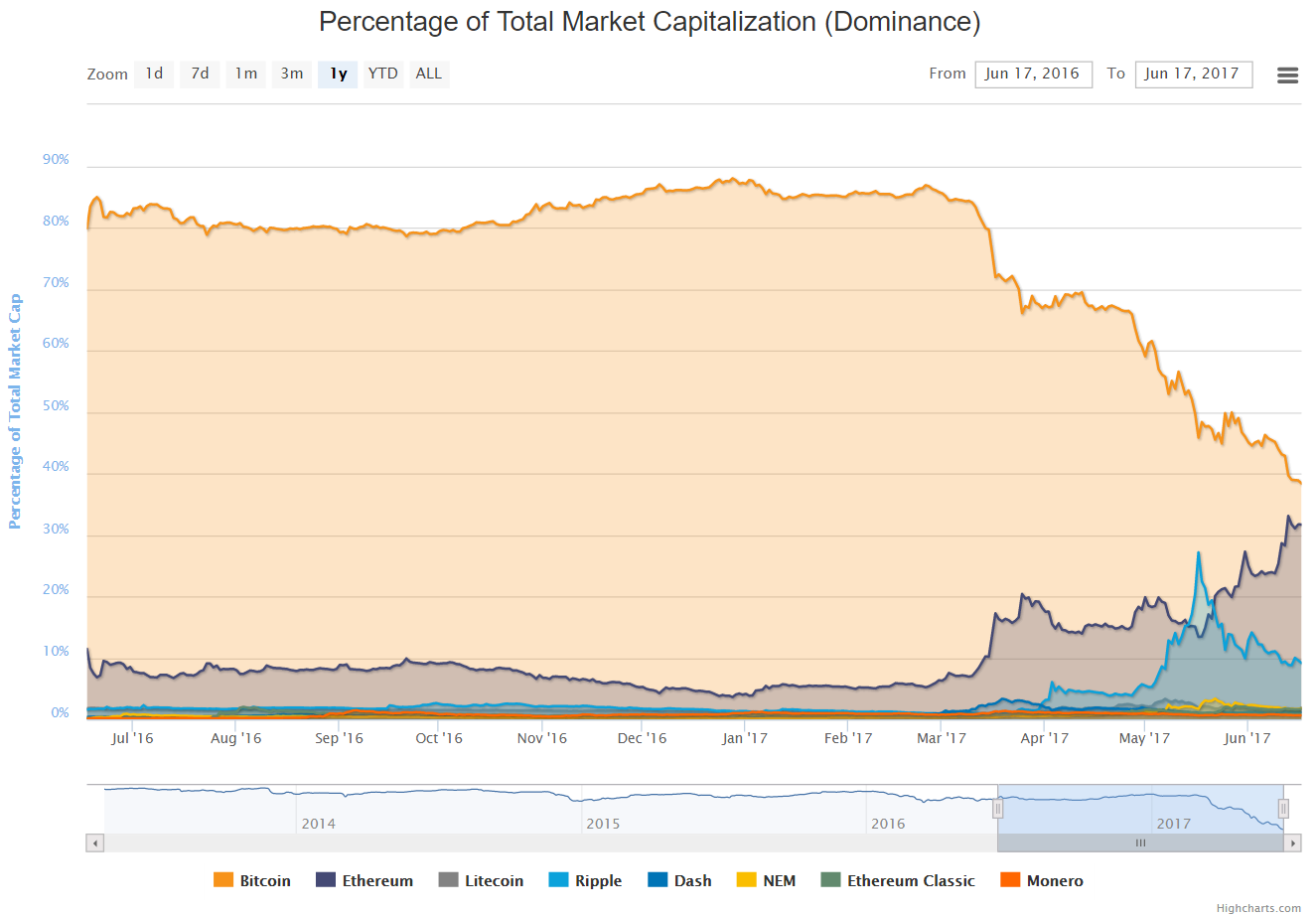Hypno Crypto – the strange world of cryptocurrencies

Mason Stevens
The recent correction in the technology sector has been particularly volatile for the so called cryptocurrencies. Cryptocurrencies are a US$112 billion market that can turn over US$5 billion a day.
There are now more types of digital cryptocurrencies than there are official government fiat currencies, although most are too insignificant to matter. The two most commonly traded ones are Bitcoin, the first of its kind, and Ethereum, the new kid on the block that is on the verge of overtaking Bitcoin in terms of market dominance. Ethereum’s market capitalisation is nearing Bitcoin’s, as shown in the chart below from CoinMarketCap. Bitcoin’s market capitalisation is around US$43 billion and Ethereum’s is around US$35 billion.
By some metrics Ethereum has already overtaken Bitcoin. It has almost five times as many nodes in its network as Bitcoin, meaning more people are using their computers to support it. Ethereum also has more transactions per day.
After both hit all-time highs early last week, Bitcoin and Ethereum prices plummeted as much as 25% on Thursday, with sustained heavy traffic crashing the biggest digital currency exchange, Coinbase, which has been a recurring problem. Trading around US$3,000 at the start of the week, bitcoin plunged to an intraday low of US$2,076 before finishing the week above US$2,500. Many other digital coin rivals, such as Ripple, NEM and Monero, also experienced extreme volatility last week. Ethereum, which has risen 40-fold over the past 12 months, recovered to finish up on the week.

To understand the differences between Bitcoin and Ethereum it is necessary to understand how they work. Bitcoin is a cryptocurrency and a digital payment system released as open-source software in 2009. The system is peer-to-peer, and transactions take place between users directly, without an intermediary. These transactions are verified by network nodes and recorded in a public distributed ledger called a blockchain. Since the system works without a central repository or single administrator, Bitcoin is the first decentralized digital currency.
Bitcoin mining is the process of adding transaction records to the blockchain, which creates more bitcoins for those who perform the service. Bitcoin can be exchanged for other currencies, products and services in legal or black markets. The most popular uses currently appear to be online gambling and gaming, speculation, black market transactions, money laundering and currency conversion by people living in soft currency economies.
Bitcoin’s inventor, known as Nakamoto, set a monetary policy based on artificial scarcity at Bitcoin’s inception, such that there would only ever be 21 million bitcoins in total. Once that point is reached the decentralised record keeping will be rewarded by transaction fees only.
Ethereum is an open-source, public, blockchain-based distributed computing platform featuring smart contract (scripting) functionality, which facilitates online contractual agreements. It provides a decentralized Turing-complete virtual machine that can execute scripts using an international network of public nodes. Ethereum provides a cryptocurrency token called “ether” that can be transferred between accounts and used to compensate participant nodes for computations performed. Ethereum’s high-level programming flexibility and support from large, mainstream companies are the main differences compared to Bitcoin.
Ethereum was proposed in late 2013 and development was funded by an online crowdsale during July-August 2014. The system went live on 30 July 2015, with 11.9 million coins “pre-mined” for the crowdsale. In 2016 Ethereum forked into two blockchains as a result of a hacking incident. The two chains have a different number of users and the minority fork was renamed Ethereum Classic. The majority fork retained the name Ethereum. Security is an ongoing concern for all cryptocurrencies.
In March 2017, various blockchain start-ups, research groups and Fortune 500 companies announced the creation of the Enterprise Ethereum Alliance (EEA). It is a non-profit organization with over 116 enterprise members that include ConsenSys, Cornell University’s research group, Toyota Research Institute, Samsung SDS, Microsoft, Intel, JP Morgan, Merck, DTCC, Deloitte, Accenture, Banco Santander, BNY Mellon, ING and National Bank of Canada.
The purpose of the EEA is to coordinate the engineering of an open-source standard and private “permissioned” version of the Ethereum blockchain that can address the common interests of enterprises in banking, management, consulting, automotive, pharmaceutical, health, technology, mobile, entertainment, and other industries, while working with developers from the Ethereum ecosystem.
Certain members of the alliance have also indicated a desire to investigate and collaborate on hybrid architectures to potentially anchor private blockchains to the public Ethereum blockchain in the future, although concerns remain over the security, compliance and regulations involved in bridging such permissioned and “permissionless” blockchains.
Some big companies are clearly backing the Ethereum horse over Bitcoin. However, the recent volatility in the value of cryptocurrencies is a warning. The primary function of any currency, crypto or otherwise, is to be a reliable store of value. With rampant speculation and competition from alternative cryptocurrencies having a large baring on the setting of value, cryptocurrencies are far from being a reliable store of value. Morgan Stanley posited last week that government acceptance will be the key to a more mature market developing for cryptocurrencies, involving some kind of regulation.
However, not all regulation is welcomed by cryptocurrency enthusiasts. A US Senate bill that targets money laundering and terrorist financing is viewed by many of them as being draconian. The bill, which was introduced in May, includes a section that singles out digital currencies and prepaid-access devices.
Cryptocurrencies are still a “frontier” market experiencing teething problems, design flaws and extreme volatility. Over time the market will mature as legitimate uses by mainstream companies increase and are supported by appropriate government regulation. For now though it is a case of buyer beware.
7 topics

Responsible for identifying domestic and international equity investment opportunities. 25 years of financial markets experience as an equity strategist, economist, analyst, portfolio manager and consultant.
Expertise

Responsible for identifying domestic and international equity investment opportunities. 25 years of financial markets experience as an equity strategist, economist, analyst, portfolio manager and consultant.
